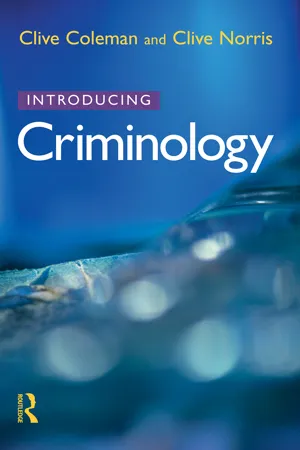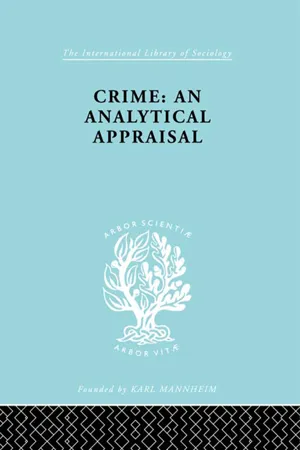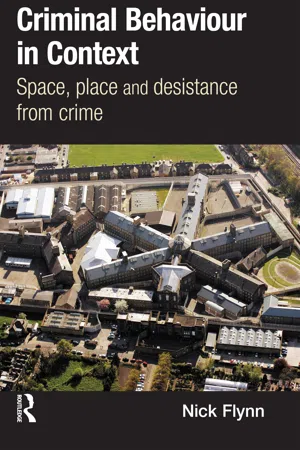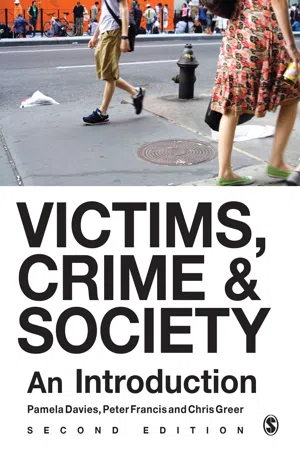Social Sciences
Social Distribution of Crime
Social distribution of crime refers to the unequal distribution of criminal behavior across different social groups and locations. It examines how factors such as race, socioeconomic status, and neighborhood characteristics influence the likelihood of individuals engaging in criminal activities. This concept is central to understanding the social causes and consequences of crime within a society.
Written by Perlego with AI-assistance
Related key terms
Related key terms
1 of 4
Related key terms
1 of 3
4 Key excerpts on "Social Distribution of Crime"
- eBook - ePub
- Clive Coleman, Clive Norris(Authors)
- 2013(Publication Date)
- Willan(Publisher)
Studies in England, on the other hand, have found that social disorganization, at least when measured by high population turnover, does not seem to hold the key (see, for example, Baldwin and Bottoms 1976). Social class, an obvious alternative explanation, is inadequate on its own, for there are many differences in offender rates between areas with a similar social composition. Studies have pointed to the following factors in creating areas with especially high rates of offender residence:• the importance of the local housing market in distributing crime-prone individuals to certain parts of the city, including the way in which council housing is allocated (e.g. some areas build up concentrations of those in most severe housing need, and likely to have other problems, in the difficult-to-let areas);• the patterns of culture and social life in an area which influence such matters as the socialization of children and friendship patterns (for example, is there a criminal subculture on an estate?) (on these first two points, see Bottoms and Wiles 1997);• the way in which a reputation as a ‘problem area’ can be generated (by, for example, media coverage focussing on an area’s problems), and have real consequences, such as in terms of decisions made by existing and potential tenants, small businesses and so on – not to move in, or to move out (see, for example, Damer 1974), thus contributing to the neighbourhood’s decline.Explaining the distribution of offences is a rather different exercise from explaining the distribution of offenders . For example, offenders do not necessarily commit their offences in the areas where they live. The traditional pattern is that offences tend to be concentrated in city centres. This is not necessarily the case for all offences (for example, domestic violence), and this pattern may alter as opportunities arise elsewhere owing to major changes in the location of opportunities (such as out of town shopping centres). The concept of opportunity 2 Crime as a social problem
It has been shown that together unknown and known but unreported crime are more extensive and serious than reported crime. Therefore criminal statistics are not the only source of knowledge about crime; officials, authorities and highly placed persons, although unpunished, are frequently offenders; and, in the main, those responsible for reported crime are a socially, economically and psychologically well-defined group.The extent of crime and the variety of social groups involved refute the thesis that it can be explained by causal generalizations, or that as a problem it can be dealt with as part of socio-economic planning. In order to be understood, it must be viewed in the light of such an ensemble as socio-economic change, the structure of the general population, political organization and stability, and politico-social values.The persistence and widespread increase of crime, in spite of all efforts to reduce it, raise a series of questions about the necessity for a new approach to the prevention of crime and the treatment of offenders; the effectiveness of criminal justice and the need to review the system of values it protects; as well as the validity of the distinction between crime and delinquency.All these questions show clearly the socio-political character of crime, both as a general and as an individual event; it is essentially a policy problem and should be dealt with as such. Scientific findings should be used within the limits imposed by political and policy considerations, among which respect for human rights is of primary importance. Owing to its complexity, crime defies scientific integration if this is understood as putting together all the parts in order to form a scientific whole.This puts crime in a different perspective which has not, up to now, been contemplated. Only recently has it been fully realized that the unknown territory of crime requires attention from a political and scientific point of view. It means that the criminal justice system should be organized so as to reduce the non-reported areas of crime, and that some of the pillars of contemporary research have to be abandoned and new ones built up.- eBook - ePub
Criminal Behaviour in Context
Space, Place and Desistance from Crime
- Nick Flynn(Author)
- 2017(Publication Date)
- Willan(Publisher)
1989: 46; emphasis in the original). Bottoms and Wiles (1992: 16) neatly summarise the reasons for the deficiency: Explanations of where offences occur, or where offenders live, can all too easily assume that place or design acts as a deterministic and monocausal variable. Alternatively, they may assume that place can stand as an operational construct for other aspects of social structure, such as class, or employment status, or family structure; or that it is simply a sorting mechanism which brings together in one place those individuals who possess criminogenic attributes (generally of a genetic or psychological kind). Nevertheless, over the past few decades, macro-physical and social transformations – ‘neo-liberalism’, ‘globalisation’, ‘the risk society’ – have recast understandings of the criminal subject and, in doing so, changed the parameters of the debate concerning the spatial distribution of crime. Critiques of wider economic and social forces suggest that crime and criminality can no longer be explained by location factors alone. Instead, criminological research must turn to ‘processes of convergence and divergence, similarities and differences between different spaces and scales and also the unevenness of seemingly global trends’ (Hughes 2007: 2). Yet, although the need to integrate knowledge on individuals and social environments and avoid assigning causal effects to single factors remains a concern of comparative criminology, rather than resolve important differences over the criminal subject, these debates have generally tended to fragment along traditional lines. Exemplified best perhaps by the reception accorded the reintroduction of classical rational man, today reborn as Homo economicus, this widely embraced discourse has severed the economic basis of offending from the social reality of crime (Young 1999) - eBook - ePub
Victims, Crime and Society
An Introduction
- Pamela Davies, Peter Francis, Chris Greer, Pamela Davies, Peter Francis, Chris Greer(Authors)
- 2017(Publication Date)
- SAGE Publications Ltd(Publisher)
10 Socio-Economic Inequalities, Victims and Crime Hazel CroallCrime has long been associated with lower socio-economic status, with poverty and worklessness and with deprived and ‘dangerous’ areas. ‘Crime’ tends to be associated with ‘offenders’, although ‘high crime areas’ are also ‘high victimisation areas’, and one noted criminologist has described crime as a ‘regressive tax on the poor’ (Downes, 1983). Indeed, the focus on offending serves to downplay the victimisation of the most disadvantaged citizens.The relationships between socio-economic inequality and victimisation are complex. All citizens are potential crime victims, and the affluent have more to steal, yet poorer victims suffer more severely from crimes which they are less able to protect themselves from. The most deprived and marginalised are also less likely or able to seek help from the police or victim support agencies. Criminal justice processes and policies also exacerbate processes of social exclusion and polarisation affecting offenders, victims and communities.This chapter will explore these issues, starting with an outline of victimological perspectives. It will go on to explore what we know about victimisation and socio-economic inequalities before looking at the situation of some of the most deprived. It will then briefly consider the impact of criminal justice policies before locating these, and crime and victimisation, in the context of social structural change.The emphasis in this chapter will be largely on victims of ‘conventional’ crimes of interpersonal violence and property, whereas victimisation from crimes of the powerful, which also impacts severely on the most disadvantaged, is the subject of Chapter 13
Index pages curate the most relevant extracts from our library of academic textbooks. They’ve been created using an in-house natural language model (NLM), each adding context and meaning to key research topics.
Explore more topic indexes
Explore more topic indexes
1 of 6
Explore more topic indexes
1 of 4



